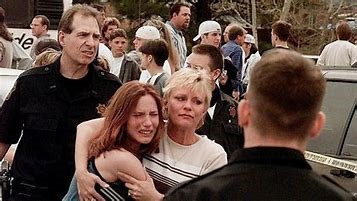The tragic event known as the Columbine High School massacre, or simply Columbine, unfolded on April 20, 1999, at Columbine High School in Columbine, Colorado, USA. It was a day marred by a school shooting combined with an attempted bombing.
The two perpetrators, Eric Harris and Dylan Klebold, both seniors at the school, carried out a meticulously planned attack that resulted in the deaths of twelve innocent students and one courageous teacher. The majority of the victims—ten students—lost their lives in the school library, where Harris and Klebold eventually took their own lives.
Beyond the thirteen people who lost their lives, the day’s mayhem included gunfire exchanges between law enforcement and the perpetrators as well as injuries to other victims. Three more people were hurt while trying to escape the site, highlighting the extensive effects of the violence.
In addition to leaving a lasting impact on the Columbine community, this tragic incident spurred national discussions about gun control, school safety, mental health awareness, and the impact of violent media on young people. The Columbine shooting serves as a sobering reminder of the necessity of taking preventative action and providing assistance to those impacted by such events.

The Columbine massacre marked a grim milestone as the deadliest mass shooting at a K-12 school in U.S. history at the time of its occurrence. However, this tragic distinction was later surpassed by subsequent horrific events such as the Sandy Hook Elementary School shooting in December 2012 and the Parkland high school shooting in February 2018. Nevertheless, Columbine still holds the heartbreaking title of the deadliest school shooting in the state of Colorado.
For more than a year, Eric Harris and Dylan Klebold meticulously plotted their attack to unleash the greatest amount of destruction possible. Their original intention was for the attack to be primarily a bombing, but when their homemade explosives failed to detonate as planned, they resorted to shooting.
The real reasons behind their actions remain unknown despite a thorough inquiry. Law enforcement’s response to the massacre was closely scrutinized, and the delayed entry into the school premises drew widespread condemnation. This tragedy led to a major increase in school security measures, including the implementation of zero-tolerance policies. It also motivated the development and adoption of the Immediate Action Rapid Deployment (IARD) technique, which is intended for use in active shooter scenarios.

The aftermath of Columbine sparked widespread debate and societal introspection, touching upon various aspects of American culture and society. Discussions ranged from the country’s gun culture and the efficacy of gun control laws to the dynamics of high school cliques and subcultures, including the treatment of outcasts and individuals perceived as different. Furthermore, issues such as school bullying, the influence of pharmaceutical antidepressants, the impact of the internet, and the portrayal of violence in video games and movies all came under intense scrutiny, contributing to a broader conversation about societal norms and their implications for youth behavior and mental health.
Many improvised tributes were created following the tragic incident, some of which used John Tomlin’s truck and Rachel Scott’s car as poignant symbols of remembrance. The crosses for Harris and Klebold were eventually removed due to criticism, but a group of fifteen crosses, initially honoring both the victims and the perpetrators, were erected atop a hill in Clement Park. However, the crosses for the perpetrators were also removed after further criticism. The Columbine Memorial opened to the public in September 2007, the result of efforts to create a permanent memorial that began in June 1999.
Even a quarter-century later, the repercussions of Columbine continue to reverberate throughout the nation, impacting even those who were not yet born at the time of the tragedy. The massacre served as a tragic template for numerous copycat incidents, known as the “Columbine effect,” which have led to deadlier shootings worldwide. The term “Columbine” has become synonymous with school shootings, prompting significant changes in school safety protocols and inspiring a sustained wave of activism. Survivors have become staunch advocates for enhanced gun control measures, offering unwavering support to the next generation of Americans affected by gun violence.
Sources




